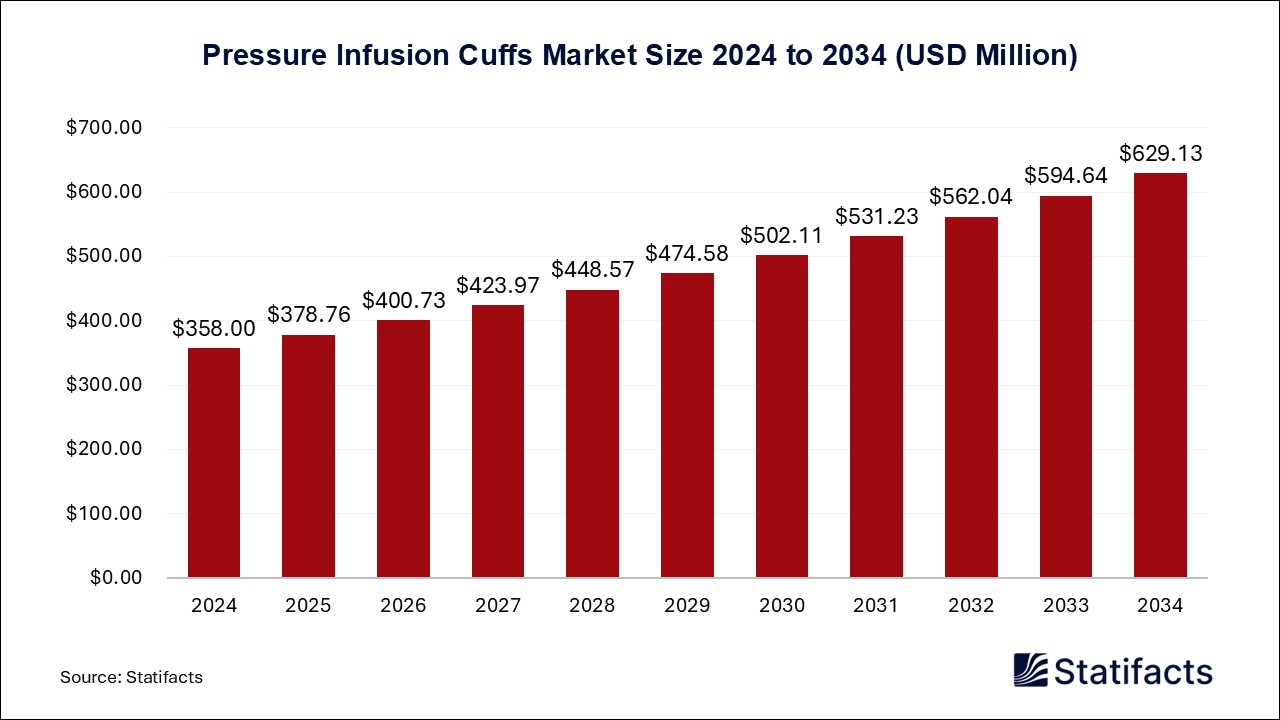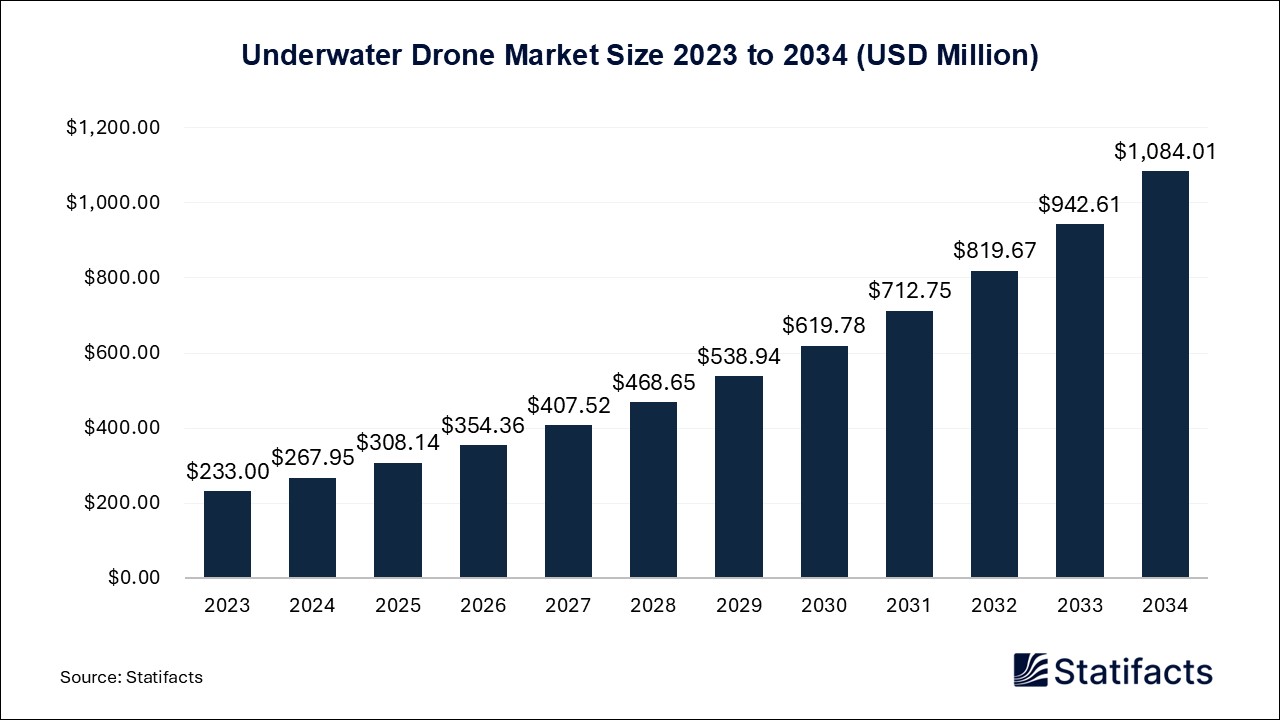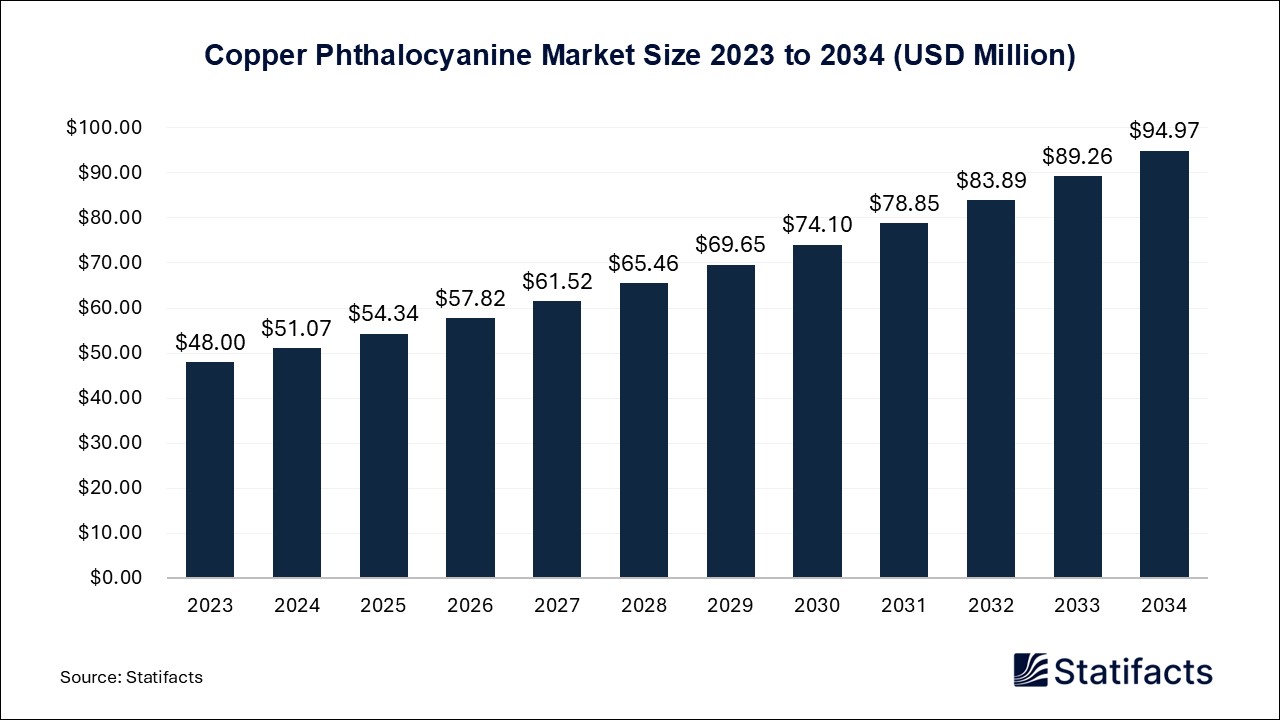Last Updated: 22 Jul 2025
Source: Statifacts
By clicking “Accept All Cookies” you agree to the storing of cookies on your device to enhance site navigation, analyze site usage, and assist in our marketing efforts.
Privacy PolicyCommercial Vehicles Market (By Vehicle Type: Light Commercial Vehicles (LCVs), Heavy Commercial Vehicles (HCVs); By Product: Light Commercial Vehicles (LCVs), Buses & Coaches, Heavy Trucks; By End-use: Industrial, Transportation, Others; By Propulsion Type; By Region: North America, Europe, Asia Pacific, Latin America, Middle East and Africa) Industry Size, Share, Growth, Trends 2025 to 2034.
The global commercial vehicles market size accounted for USD 1,082 million in 2024 and is predicted to touch around USD 11,830 million by 2034, growing at a CAGR of 27.02% from 2025 to 2034. Industrialization and urbanization continue to provide a big boost to the economy and increase the demand for commercial and passenger vehicles.
| Industry Worth | Details |
| Market Size in 2025 | USD 1,374 Million |
| Market Size by 2034 | USD 11,830 Million |
| Market Growth Rate from 2025 to 2034 | CAGR of 27.02% |
Commercial vehicles are used across various industries to transport goods, materials, and passengers. With the rise of e-commerce, demand for efficient logistics systems, and industrialization, the market finds its growth. Infrastructure development in emerging economies also facilitates better road connectivity for the easy movement of goods. Companies are redefining the markets as they seek environment-friendly and cost-effective transport solutions. The market consists of light commercial vehicles, buses, coaches, and heavy-duty trucks. Technological changes, government incentives for clean energy vehicles, and smart fleet management systems are also other motivations driving the demand for commercial vehicles worldwide.
From a commercial point of view, the integration of AI in vehicles enriches their safety, performance, user experience, and manufacturing. AI in ADAS contributes to road safety through lane-keeping assist, adaptive cruise control, and automatic emergency braking. Predictive maintenance offers reliability by spotting faults before they cause a breakdown.
Then, AI helps to enrich the driving experience with smart voice assistants, personalized infotainment, and adaptive driving features. As for fuel economy, AI gains the information through analyzing driving data in real-time so that the engine performs accordingly and extends the life of the vehicle by preventative maintenance. On the other hand, AI aids the manufacturing process by means of inspecting quality control and identifying defects in production, and diagnosing equipment for maintenance. These improvements shortened the production time, cut average product costs, and increased productivity.
The major market drivers in the commercial vehicles market are multifaceted, encompassing economic factors, consumer preferences, and technological advancements, with a growing influence from the rise of EVs
The growth of the commercial vehicles market is restrained by factors such as environmental impact, economic factors, and consumer preferences.
Environmental Impact: Market revival and growth are hindered with the cars' environmental footprint is being taken into serious consideration, for they carry forward the biggest chunk of emissions of Greenhouse Gases and air pollutants, thus leading to climate change and urban air-quality issues. Energy and water are consumed tremendously during production activities, and large amounts of waste are also generated, whereas recycling and disposing away create further problems. In the offers of increasing environmental consciousness, consumers, policymakers class, and regulatory bodies are irresistibly forcing manufacturers to look toward restricting emissions and practicing sustainability. This very trend is shifting the focus away from the traditional ICE vehicles toward those that emit less, such as hybrids and electric vehicles, and liberalizing vehicle growth for them in favor of more eco-friendly companies.
Safety Regulations: Because of strict safety regulations and augmented production costs, the market for commercial vehicles is encountering a headwind. These crash safety standards are becoming stricter with emission norms and fuel economy standards, such that manufacturers are forced to integrate several advanced technologies. This phenomenon has, by itself, inflated the cost of production, and hence, traditional vehicles might be beyond the reach of price-conscious buyers. Price competition, along with regulatory compliance, becomes a hard feat to perform in those locations that have been very bullish on emission reduction targets. From an economic standpoint, variable fuel prices and high ownership costs will keep gross buyers most intrigued. Given this, the commercial vehicle segment would begin losing its strong position if cheaper options such as electric vehicles come into being.
The opportunities in the commercial vehicles market are associated with environmental impact, economic factors, and consumer preferences.
Fuel Efficiency and Alternative Fuels: While technological advances in EVs steal most of the limelight, improvements in fuel efficiency and alternative fuel technologies can still be bestowed on the commercial vehicle market. Internal combustion engines perform the act of muscle-building and fuel-saving through fine-tuned technologies like direct fuel injection and turbocharging, and variable valve timing. When lightweight materials and basic aerodynamics are employed, fuel efficiency can be further raised. Alternative fuels like biofuels, CNG, and hydrogen are pleasing to nature and meet the ambitious emission standards; thus, they are favored. Finally, hybrid powertrains marry the electric motor with the ICE to obtain even better fuel efficiency and lower emissions without full EV infrastructure. These innovations support world sustainability ambitions and provide avenues to grow and compete meaningfully in the commercial and personal vehicle segments.
New Business Models: The automotive industry monetizes data and services to forge newer business opportunities in the commercial vehicle market. Vehicles chock-full of sensors and connected systems gather real-time data for predictive maintenance, usage-based insurance, or perhaps even personalized driving insights. A SaaS-type arrangement could provide subscription access to new navigation updates and driver assistance features, thereby fostering a recurring revenue stream and increasing customer engagement. The aftermarket segment for commercial vehicles remains viable and lucrative, permitting the value-added services and new business models to help manufacturers and service providers attain diversification into their income streams and an extension into the life cycle profitability of traditional vehicle platforms.
“With more than seven lakh vehicles sold in just seven years, the Nexon has created a distinct mark for itself amongst customers in India’s growing SUV market. Nexon’s popularity has steadily increased, driven by well-timed and innovative technological upgrades. Today’s new launches further enhance its appeal. These additions take forward Tata Motors’ successful multi-powertrain strategy and ensure that there is indeed a Nexon for every need.”
Although the purchase price of electric vehicles is higher than diesel trucks, we have achieved higher efficiency and cost reductions in the long term. Through a joint effort with our partner, we have optimised the route, ensuring the truck is used more on the road and less during idling in loading and unloading processes.”
The heavy trucks segment dominated in commercial vehicles, increasing as a strong demand comes for freight transport solutions in long-haul, construction, and industrial logistics. The manufacturers are keen to invest in engineering improvements to deliver better performance, emission standards, and fuel economy. Environmental regulations are forcing the segment to adopt cleaner forms of propulsion systems, like hybrid and alternative fuel vehicles. Safety and suspension systems innovations enhance driver comfort and road handling in the most challenging situations. The segment is further gaining along with the growth of smart logistics systems that demand truck operations under very demanding workloads.
LCVs are an influential commercial vehicle as it is versatile and operationally efficient, with applicability in different industrial domains. They find ample application in transporting goods or services, primarily in the fields of e-commerce, logistics, construction, and manufacturing. Their ease of maintenance, smaller size, and lower running cost contribute heavily to their widespread adoption. With better technology integration, such as connectivity and driver-assist features, fleet management gets even better. The LCV segment gets momentum from steadily increasing industrial activities and a growing need for flexible systems of delivery. With electrification as a trend, innovation gets its push in order to make LCVs more environmentally sustainable and cost-efficient.
By propulsion type, the IC engine dominated the global commercial vehicles market. Commercial ICE vehicles with internal combustion engines are the mainstream commercial vehicle due to the extensive infrastructure supporting them, their reliability, and their capacity to be used under different situations. In terms of intercity travel and weight-laden operation, they fit industrial, transportation, and logistics use. With ICE technology being fully matured, manufacturers have now been able to optimize engines with respect to power output and fuel economy, along with reduced emissions and operational costs. Even with weak global refueling infrastructure and supply chains, diesel and gasoline vehicles can still be the best choice for cash-strapped businesses. One of the many benevolent advantages of the internal combustion engine vehicle is that it can be modified for mass transit operation in both urban and rural areas.
Environmentally conscious issues and government subsidies are the rapid drivers of the growth of electric commercial vehicles. They do not produce tailpipe emissions, are less costly to operate, and work quietly, making them suitable for urban deliveries-because they have to be permitted in environmentally sensitive zones. Businesses are slowly moving towards electric vehicles so as to fulfil regulatory standards aligned with corporate sustainability goals. New advances in battery capacity will further deliver efficient charging infrastructure and better vehicle range, thus making electric vehicles more practical. Finally, design, production, and processes are undergoing continuous improvement with further enhancements to performance, safety, and cost.
The transportation sector commands a large share of the commercial vehicle market owing to trips for the movement of passengers and goods. Commercial vehicles are essential for commuting, passenger transport, and cargo delivery. Demand is driven by the burgeoning population, urbanization, and the growing need for cost-effective, accessible transport options. Governments and private operators invest in both road network improvements and enhancements of public transportation systems. Ride-sharing and on-demand ride services, on the other hand, aid in facilitating sales to an extent. Commercial vehicles score high on the reliability axis and hence on the availability and familiarity axes, whereas enhanced features improve the acceptance by consumers.
Logistics is the fastest-growing end-category in the commercial vehicles industry, owing to global trade, e-commerce, and last-mile delivery. There is an increasing demand for specialized commercial vehicles due to the desire of companies for quick and reliability in delivery. Digital via telematics, GPS tracking, and route optimization tools are the pillars for improving the efficiency and productivity of logistics fleets. In the race to achieve timely and cost-efficient delivery solutions, companies invest in the latest commercial vehicles.
Diesel engines are still the most common power sources, largely due to their efficiency, durability, and power output for long hauls and heavy-load operations. Diesel Trucks have max torque considerations and fuel usage, so that fleets can use these vehicles under many conditions. Another factor that enhances the preference is the established infrastructure for refueling and maintenance of diesel vehicles. Compared with diesel vehicles, they gain a longer engine life and are cheaper to operate in terms of fuel costs; hence, they present a cheaper option for ownership. Over recent years, there have been more and more considerations on electric and alternative fuels; thus, diesel will always stand as a known powerhouse for logistics, construction, and industrial transportation.
The fuel cell segment is expected to grow at the fastest rate during the forecast period. The opportunity with zero-emission transport, which does not compromise on performance or range, is what is fueling the exponential growth of commercial fuel cell vehicles. Being hydrogen-powered, this vehicle produces water vapor as the only byproduct and hence finds its use as a major choice to be considered by means for long-haul transportation and heavy-duty applications. Investment in hydrogen infrastructure, which includes research, and conducive government policy, helps the growth. Technological improvements have led to availability in fuel cell efficiencies, longer durability, and lower cost, and thus, the commercialization of fuel cells is now evident. Fuel Cell Vehicles are slowly picking up as a renewable and scalable option under commercial mobility.
Due to its strong industrial growth, efficient infrastructure, and highly stringent regulations, North America enjoys dominance over the global commercial vehicle market. An integrated supply chain connects various manufacturers, distributors, and consumers across multiple types of transport in the area. Government initiatives back demand for long-distance fleet operations, as well as for electric vehicles. Market growth is further buoyed by the presence of leading automotive manufacturers and easy financing options. Online taxi and car rental facilities also boost the market.
The commercial vehicle market is exploding in the Asia Pacific because of industrialization, urbanization, and infrastructure advances being carried out here. The region, with its cheap raw materials and cheap labor, and with rising manufacturing capabilities, presents an attractive production and adoption platform. Governments forward the idea of smart mobility with sustainable transport policies, and further augment this vision with the promotion of electric vehicles and cleaner technologies. The region has a large population, and with an increasing number of industries, there is a huge demand for goods transport, with car rental and shared mobility services supporting the commercial vehicle requirement. The countries are investing in sustainable public transport solutions for achieving Carbon Neutrality.
The market is moderately fragmented, with local players including Bosch Rexroth AG, TATA Motors, Volkswagen AG, Ashok Leyland, Toyota Motor Corporation, VOLVO, Daimler, Mahindra, and others. General Motors, Golden Dragon, etc., wish to take the time to expand their presence through investments, partnerships, acquisitions, and mergers. They also invest in product development and competitive pricing. These strategies will promote market growth and lucrative opportunities for market players
Tata Motors' consolidated revenue for fiscal year 2023-24 was around ₹3.5 lakh crore. In 2023, the company's revenue was reported as $ 52.9 billion.
Ashok Leyland's revenue for the year 2024 was ₹45,931 crore (US$5.4 billion).
The company's revenue for 2023 was $351.2 billion.
| Regions | Shares (%) |
| North America | 28% |
| Asia Pacific | 40% |
| Europe | 25% |
| LAMEA | 7% |
| Segments | Shares (%) |
| Light Commercial Vehicles (LCVs) | 48% |
| Heavy Commercial Vehicles (HCVs) | 52% |
| Segments | Shares (%) |
| Light Commercial Vehicles (LCVs) | |
| Buses & Coaches | |
| Heavy Trucks |
| Segments | Shares (%) |
| Industrial | 45% |
| Transportation | 40% |
| Others | 15% |
| Segments | Shares (%) |
| IC Engine | 78% |
| Electric Vehicle | 22% |
| Segments | Shares (%) |
| Gasoline | 18% |
| Diesel | 42% |
| HEV / PHEV | 15% |
| Battery Electric Vehicle (BEV) | 12% |
| Fuel Cell Vehicle | 5% |
| LPG & Natural Gas | 8% |
Published by Ajit Bansod
| Vehicle Type | 2024 | 2025 | 2026 | 2027 | 2028 | 2029 | 2030 | 2031 | 2032 | 2033 | 2034 |
|---|---|---|---|---|---|---|---|---|---|---|---|
| LCVs | 562 | 715 | 910 | 1157 | 1471 | 1870 | 2377 | 3020 | 3840 | 4873 | 6180 |
| HCVs | 520 | 662 | 842 | 1070 | 1360 | 1729 | 2196 | 2790 | 3546 | 4471 | 5671 |
| Product | 2024 | 2025 | 2026 | 2027 | 2028 | 2029 | 2030 | 2031 | 2032 | 2033 | 2034 |
|---|---|---|---|---|---|---|---|---|---|---|---|
| LCVs | 389 | 496 | 631 | 801 | 1015 | 1289 | 1637 | 2080 | 2643 | 3352 | 4250 |
| Buses & Coaches | 162 | 203 | 258 | 327 | 414 | 526 | 670 | 853 | 1083 | 1373 | 1740 |
| Heavy Trucks | 531 | 678 | 863 | 1099 | 1318 | 1784 | 2236 | 2877 | 3660 | 4619 | 5861 |
| Region | 2024 | 2025 | 2026 | 2027 | 2028 | 2029 | 2030 | 2031 | 2032 | 2033 | 2034 |
|---|---|---|---|---|---|---|---|---|---|---|---|
| North America | 325 | 414 | 530 | 678 | 865 | 1100 | 1390 | 1760 | 2230 | 2830 | 3580 |
| Asia Pacific | 378 | 483 | 618 | 784 | 997 | 1260 | 1590 | 2020 | 2580 | 3290 | 4190 |
| Europe | 270 | 345 | 442 | 562 | 716 | 915 | 1155 | 1470 | 1870 | 2380 | 3030 |
| LAMEA | 108 | 138 | 178 | 251 | 291 | 307 | 337 | 376 | 434 | - | - |
Last Updated: 22 Jul 2025
Source: Statifacts
| Subsegment | 2024 | 2025 | 2026 | 2027 | 2028 | 2029 | 2030 | 2031 | 2032 | 2033 | 2034 |
|---|---|---|---|---|---|---|---|---|---|---|---|
| LCVs | 562 | 715 | 910 | 1157 | 1471 | 1870 | 2377 | 3020 | 3840 | 4873 | 6180 |
| HCVs | 520 | 662 | 842 | 1070 | 1360 | 1729 | 2196 | 2790 | 3546 | 4471 | 5671 |
| Subsegment | 2024 | 2025 | 2026 | 2027 | 2028 | 2029 | 2030 | 2031 | 2032 | 2033 | 2034 |
|---|---|---|---|---|---|---|---|---|---|---|---|
| LCVs | 389 | 496 | 631 | 801 | 1015 | 1289 | 1637 | 2080 | 2643 | 3352 | 4250 |
| Buses & Coaches | 162 | 203 | 258 | 327 | 414 | 526 | 670 | 853 | 1083 | 1373 | 1740 |
| Heavy Trucks | 531 | 678 | 863 | 1099 | 1318 | 1784 | 2236 | 2877 | 3660 | 4619 | 5861 |
| Subsegment | 2024 | 2025 | 2026 | 2027 | 2028 | 2029 | 2030 | 2031 | 2032 | 2033 | 2034 |
|---|---|---|---|---|---|---|---|---|---|---|---|
| North America | 325 | 414 | 530 | 678 | 865 | 1100 | 1390 | 1760 | 2230 | 2830 | 3580 |
| Asia Pacific | 378 | 483 | 618 | 784 | 997 | 1260 | 1590 | 2020 | 2580 | 3290 | 4190 |
| Europe | 270 | 345 | 442 | 562 | 716 | 915 | 1155 | 1470 | 1870 | 2380 | 3030 |
| LAMEA | 108 | 138 | 178 | 251 | 291 | 307 | 337 | 376 | 434 | - | - |
Growth is supported by e-commerce expansion and urban logistics demands, as firms upgrade light and medium-duty fleets. Government infrastructure investment and regulatory pressure to modernize commercial fleets further boost demand.
Adoption of hybrid and electric commercial vehicles is accelerating, driven by stricter emission standards and incentives. Companies and governments increasingly favor cleaner powertrains across light and heavy-duty segments.
Challenges include tight emissions regulations, labor shortages (especially drivers and technicians), regulatory complexity, and high capital costs for electrification and clean-fuel infrastructure.
Advanced telematics, AI-driven route optimization, predictive maintenance, and early-stage autonomous trucking (e.g., Level 4 middle-mile operations) are driving efficiency, safety, and operational intelligence.
Light commercial vehicles currently dominate revenue share, while electric and hybrid commercial vehicles, particularly in urban and delivery use cases, are growing fastest, reflecting market-wide electrification.
To get full access to our Market Insights, you need a Professional Account or a Business Suite.

You will receive an email from our Business Development Manager. Please be sure to check your SPAM/JUNK folder too.

You will receive an email from our Business Development Manager. Please be sure to check your SPAM/JUNK folder too.

Our customers work more efficiently and benefit from



